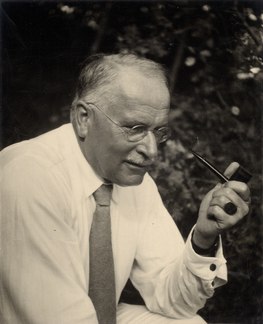
Back علم النفس التحليلي Arabic سايكولوجيا تحليليه ARZ বিশ্লেষণাত্মক মনোবিজ্ঞান Assamese Sicoloxía analítica AST Analitik psixologiya Azerbaijani تحلیلی سایکولوژی AZB Аналитична психология Bulgarian বিশ্লেষণাত্মক মনোবিজ্ঞান Bengali/Bangla Psicologia analítica Catalan دەروونناسیی شیکارانە CKB
This article is missing information about status of this theory in modern scientific circles. (November 2022) |

| Part of a series of articles on |
| Psychoanalysis |
|---|
 |
Analytical psychology (German: Analytische Psychologie, sometimes translated as analytic psychology and referred to as Jungian analysis) is a term coined by Carl Jung, a Swiss psychiatrist, to describe research into his new "empirical science" of the psyche. It was designed to distinguish it from Freud's psychoanalytic theories as their seven-year collaboration on psychoanalysis was drawing to an end between 1912 and 1913.[1][2][3] The evolution of his science is contained in his monumental opus, the Collected Works, written over sixty years of his lifetime.[4]
The history of analytical psychology is intimately linked with the biography of Jung. At the start, it was known as the "Zurich school", whose chief figures were Eugen Bleuler, Franz Riklin, Alphonse Maeder and Jung, all centred in the Burghölzli hospital in Zurich. It was initially a theory concerning psychological complexes until Jung, upon breaking with Sigmund Freud, turned it into a generalised method of investigating archetypes and the unconscious, as well as into a specialised psychotherapy.
Analytical psychology, or "complex psychology", from the German: Komplexe Psychologie, is the foundation of many developments in the study and practice of psychology as of other disciplines. Jung has many followers, and some of them are members of national societies around the world. They collaborate professionally on an international level through the International Association of Analytical Psychologists (IAAP) and the International Association for Jungian Studies (IAJS). Jung's propositions have given rise to a multidisciplinary literature in numerous languages.
Among widely used concepts specific to analytical psychology are anima and animus, archetypes, the collective unconscious, complexes, extraversion and introversion, individuation, the Self, the shadow and synchronicity.[5][6] The Myers–Briggs Type Indicator (MBTI) is loosely based on another of Jung's theories on psychological types.[5][7][8] A lesser known idea was Jung's notion of the Psychoid to denote a hypothesised immanent plane beyond consciousness, distinct from the collective unconscious, and a potential locus of synchronicity.[9]
The approximately "three schools" of post-Jungian analytical psychology that are current, the classical, archetypal and developmental, can be said to correspond to the developing yet overlapping aspects of Jung's lifelong explorations, even if he expressly did not want to start a school of "Jungians".[5]: 50–53 [10] Hence as Jung proceeded from a clinical practice which was mainly traditionally science-based and steeped in rationalist philosophy, anthropology and ethnography, his enquiring mind simultaneously took him into more esoteric spheres such as alchemy, astrology, gnosticism, metaphysics, myth and the paranormal, without ever abandoning his allegiance to science as his long-lasting collaboration with Wolfgang Pauli attests.[11] His wide-ranging progression suggests to some commentators that, over time, his analytical psychotherapy, informed by his intuition and teleological investigations, became more of an "art".[5]
The findings of Jungian analysis and the application of analytical psychology to [12] contemporary preoccupations such as social and family relationships,[13][page needed] dreams and nightmares, work–life balance,[14] architecture and urban planning,[15][page needed] politics and economics, conflict and warfare,[16][page needed] and climate change are illustrated in several publications and films.[17][18][page needed][19][20][page needed]
- ^ Jung CG (1912). Neue Bahnen in der Psychologie [New Pathways in Psychology] (in German). Zürich.
{{cite book}}: CS1 maint: location missing publisher (link) - ^ Samuels A, Shorter B, Plaut F (1986). A Critical Dictionary of Jungian Analysis. London: Routledge and Kegan Paul. ISBN 978-0-415-05910-7.
- ^ "Analytic Psychology". Encyclopaedia Britannica.
- ^ Collected Works of C.G. Jung, Complete Digital Edition. Princeton University Press. March 2014. ISBN 9781400851065. Retrieved 23 January 2014.
- ^ a b c d Fordham M (1978). Jungian Psychotherapy: A Study in Analytical Psychology. London: Wiley & Sons. pp. 1–8. ISBN 0-471-99618-1.
- ^ Stevens A (1990). Archetype: A Natural History of the Self. Hove: Routledge. ISBN 978-0-415052207.
- ^ Jung CG (1 August 1971). "Psychological Types". Collected Works of C. G. Jung, Volume 6. Princeton University Press. ISBN 978-0-691-09770-1.[page needed]
- ^ McCrae R, Costa P (1989), Reinterpreting the Myers-Briggs Type Indicator from the perspective of the five-factor model of personality.
- ^ Addison A (2009). "Jung, vitalism and 'the psychoid': an historical reconstruction". Journal of Analytical Psychology. 54 (1): 123–142. doi:10.1111/j.1468-5922.2008.01762.x. PMID 19161521.
- ^ Samuels A (1985). Jung and the Post-Jungians. London: Routledge & Kegan Paul. pp. 11–21. ISBN 0-7100-9958-4.
- ^ Remo FR (2012). Return of the World Soul, Wolfgang Pauli, C. G. Jung and the Challenge of Psychophysical Reality [unus mundus], Part 2: A Psychophysical Theory. Pari Publishing. ISBN 978-88-95604-16-9.
- ^ Merchant J (31 May 2024). "Working Online During the Contemporary COVID-19 Pandemic". Journal of Analytical Psychology. 68 (2): 281–300. doi:10.1111/1468-5922.12899. PMID 36866701.
- ^ Samuels A, ed. (1985). The Father: Contemporary Jungian Perspectives. London: Free Association Books. ISBN 978-0-946960-28-6.
- ^ Kutek A (1999). "The terminal as a substitute for the interminable?". Psychodynamic Counselling. 5: 7–24. doi:10.1080/13533339908404188.
- ^ Huskinson, Lucy (2018). Architecture and the Mimetic Self: A Psychoanalytic Study of How Buildings Make and Break Our Lives. Routledge. ISBN 978-0-415-69303-5.
- ^ Redfearn JW (1992). The Exploding Self: The Creative and Destructive Nucleus of the Personality. Chiron.
- ^ Wisdom of the Dream (Carl Jung). Clayton Micallef - Explore Your Inner World – via YouTube.
- ^ Hubback J (2013). People Who Do Things to Each Other. Chiron Publishers. ISBN 978-0-933029279.
- ^ Schaverien J (2015). Boarding School Syndrome. Routledge. ISBN 978-0415690034.
- ^ Mathers D, ed. (2021). Depth Psychology and Climate Change: The Green Book. Routledge. ISBN 978-0-367-23721-9.